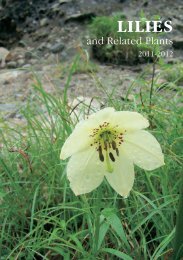LILIES - RHS Lily Group
LILIES - RHS Lily Group
LILIES - RHS Lily Group
Create successful ePaper yourself
Turn your PDF publications into a flip-book with our unique Google optimized e-Paper software.
The 1932 Conference Show Schedule comprised over two dozen classes. The<br />
first fifteen were for a single stem of lilies including (as then listed) LL. canadense,<br />
croceum, Duchartrei var. Farreri, martagon, pardalinum, Philippinense var.<br />
Formosanum, regale, Szovitsianum, x testaceum, and umbellatum followed by<br />
classes for lilies in pots up to 12 in. in diameter, one for three lily species suited to<br />
rock garden or alpine house, and two classes for substantial table arrangements<br />
featuring lilies. Sadly the available records do not show the number of entries in<br />
what might seem today an impossibly ambitious schedule.<br />
Following the Conference, two entries in the Committee minutes bring to mind<br />
the changes in social structure and attitudes which have taken place since 1933. First<br />
Dr Stoker criticised Conference Regulation 37, the second part of which read:<br />
“Prize money is paid to the exhibitor’s gardener (when known) unless the<br />
exhibitor has informed the Secretary that he prefers some other arrangement.”<br />
In reply to Dr Stoker, Sir William Lawrence said that such an arrangement was<br />
common to all shows where money prizes were given. A matter of such fundamental<br />
importance as this was duly referred to the Council but there is no record in the<br />
minutes of the <strong>Lily</strong> Committee of the result of Council’s deliberation upon it!<br />
Secondly, in the minutes of the same day’s meeting, it was simply reported<br />
that the President (of the <strong>RHS</strong>) and the Chairman (of the <strong>Lily</strong> Committee) were to<br />
meet to discuss “the advisability of publishing a list of the President’s guests at the<br />
dinner which he gave on the first evening of the International <strong>Lily</strong> Conference”.<br />
At the Council meeting of 25 October 1932, Stern had presented a memorandum<br />
calling for the formation of a lily group: “Many members of the <strong>RHS</strong> and others<br />
have asked me during the past year how to join the <strong>Lily</strong> Society! The Council will<br />
remember that the <strong>Lily</strong> Committee was created primarily to avoid another new<br />
Society being formed, but there is no doubt that there is a want among member<br />
and the public to join some body devoted to lilies and their culture, where they<br />
can air their views and hear other views on their especial subject”.<br />
The objects of the <strong>Lily</strong> <strong>Group</strong> were to be: “to encourage the cultivation of lilies,<br />
fritillaries and nomocharis by holding meetings for lectures and discussions, by<br />
visiting gardens where these plants are well-grown, and by holding an annual<br />
dinner for those interested in the three genera.” It was open to all Fellows and<br />
Associates of the Society who wished to join with no extra subscription. The<br />
inaugural meeting took place in the Old Hall on 21 March 1933. The first <strong>Group</strong><br />
visit was to the gardens of E.A. Bowles and Fred Stoker in July 1933.<br />
An important feature of the <strong>Lily</strong> Committee’s activities during the immediately<br />
pre-war years was its <strong>Lily</strong> Research Sub-Committee consisting of Stern, Cotton,<br />
Stoker, Daniel Hall and Lawrence Ogilvie, who had reported to the Conference<br />
on lily mosaic disease. The first scientific activity of the <strong>Lily</strong> Committee was to<br />
31




